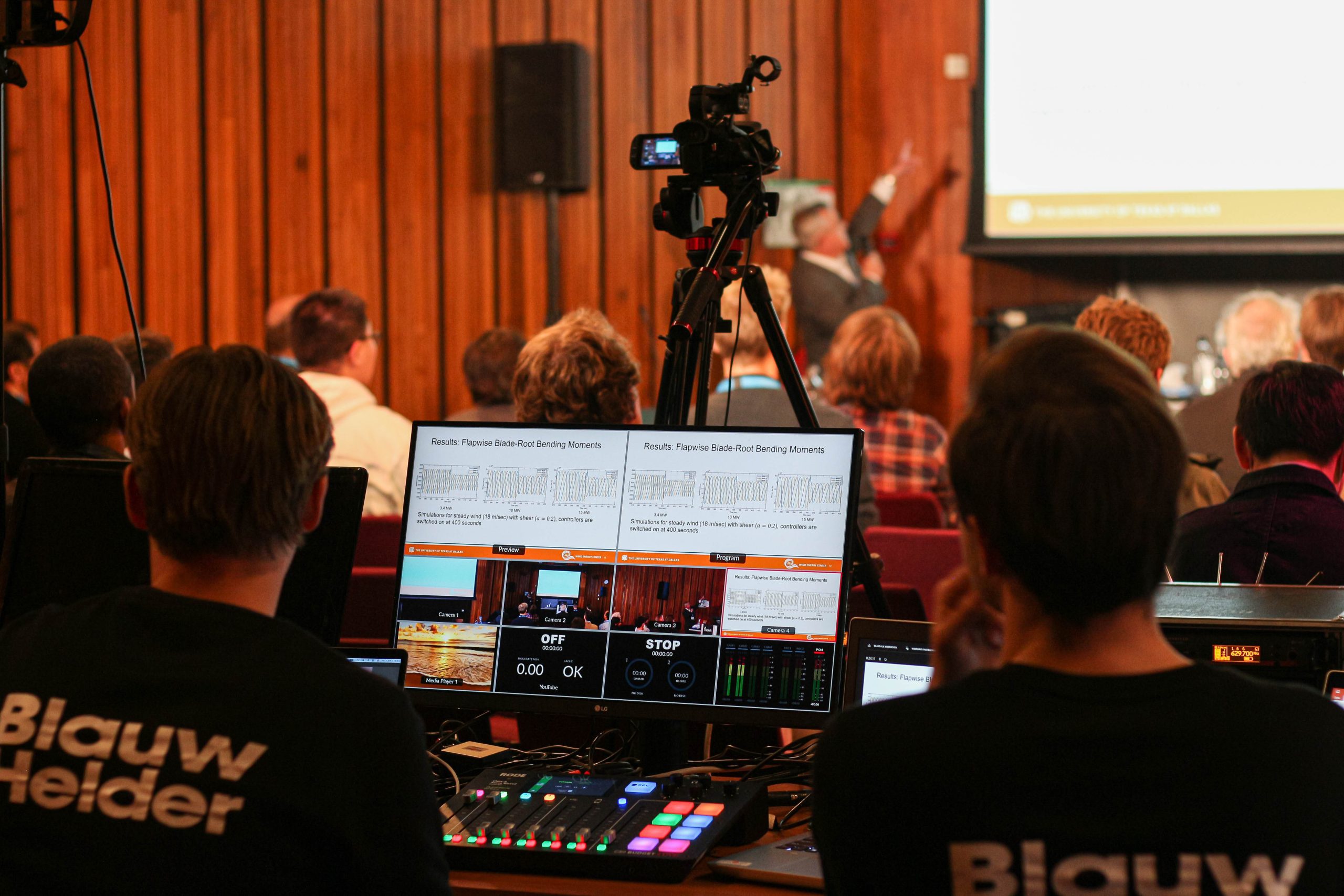Uncertainty about Covid is raising questions about hybrid conferences this year. Is hybrid, where live events and online access run in parallel, the new trend?
A hybrid conference requires lots of extra equipment and staff. (Photo: Justyna Botor)
Wrapped in dark blue T-shirts, the students do their work silently. TORQUE22, the big wind energy conference, is underway in different parts of the Aula and can be attended worldwide. During a presentation, former IDE student Alexander van Citters walks into one of the halls as quietly as he can and discusses something with two people in his team. They are sitting at the back of the hall with a legion of screens in front of them. Their fingers touch light emitting control panels, sound mixers and keyboards. They decide what the online attendees get in terms of camera images, sound and PowerPoints. They send questions and comments that arrive in the chat to the facilitator at the appropriate time. Silent, hidden but alert, the working students are the link between what happens in the hall and in the outside world. They take care of the online access as technicians or moderators. During the Covid period, Van Citters’ Blauwhelder (clear blue) start-up grew from a budget streaming service to a facility company that uses its own people and resources to put large conferences online.
The first online conferences came about when researchers were not able to meet each other during the Covid lockdowns. The idea that technology can be used for online access as an addition to live events even after Covid started to take shape. In the meantime, researchers are now attending conferences again, as they did last week at TU Delft. Does online access then have added value? Are hybrid conferences the way of the future? Yes, thinks Pouya Foroutan, Department Manager of TU Delft Event Solutions, but not for all gatherings. Why is this?
Climate impact
At TU Delft, Hydraulic Engineering Professor Wim Uijttewaal (CEG) was pushed into becoming a pioneer in hybrid conferences when he was involved in the River Flow conference in 2020. After the Covid outbreak at the start of 2020, the organisers had to race head over heels to switch to a remote meeting. Uijttewaal and his colleagues opted to make all the contributions, readings and PowerPoint presentations available online. There was no schedule. This may have made access flexible, but it also made everything optional and there was no interaction.
‘People tend to quickly revert back to their old habits’
“I am now convinced that we need to move away from the conventional way of attending congresses,” said Uijttewaal afterwards enthusiastically. “Everyone flies in from all over the world. Can we afford to do that at a time when everyone is being asked to contribute to CO2 reduction?”
Two years on and he is less optimistic about the climate contribution of hybrid conferences. “I do not see any structural change in behaviour. People tend to quickly revert back to their old habits. They find the climate issue too big to solve by not travelling, so they simply start travelling again.”

Camera’s in auditoria are required, but not sufficient to make hybrid conferencing work. (Photo: Justyna Botor)
Adapting the programme
Putting a camera in the venue and streaming the recording is pointless, says Pouya Foroutan. Apart from a few highly motivated people, most people will then not attend. Apart from a lot of technical aspects, hybrid conferences also require a different king of programming. Shorter talks, more parallel sessions and workable means for online attendees to respond. In practice this means more cameras, more online platforms and more directors and moderators to facilitate interaction effectively. To keep the costs down, an organisation could opt for making one day or a half day accessible online and the rest of the event not. Better short and good than long and tedious.
Foroutan estimates that the additional costs for online services come to between 20% and 100% of the budget for a live event, depending on how comprehensive it is. “The uncertainty about Covid is now causing a peak in hybrid conferences. Employers outside the region see Europe as a contaminated region and prefer their people not to go there.” Thus, all the conferences held in the Aula this year will be hybrid.
Added value
“People prefer live events,” says Professor of Wind Energy and Chair of DUWIND Simon Watson (AE). He is one of the organisers of the TORQUE22 conference that is being physically attended by 560 people and with 80 online attendees. For Watson, the videos of the meetings and presentations are the most important reasons to go hybrid. What he did find though, is that the organisation behind a hybrid conference has to keep time even more strictly. Online visitors are very punctual.
Physical attendance of the conference cost about EUR 520, online access a little more than half at EUR 310. Watson does not believe that the extra costs for the organisers for the online facilities and services should be an issue. “The biggest costs are always the catering. We did vegetarian food and everyone was very complimentary.” The catering was not for the online attendees of course.

Department Manager Pouyan Foroutan foresees a drop back in the number of hybrid events because of the extra costs. (Photo: Justyna Botor)
Finding the balance
“If 10% of the attendees are online attendees, but the extra costs are 30%, a hybrid conference is not commercially attractive anymore,” calculates Foroutan. Are hybrid conferences viable then? Foroutan believes that they are, but not for every conference.
Small gatherings such as PhD conferral ceremonies have been hybrid since Covid as a matter of course. TU Delft has invested in cameras, microphones, and computers to allow external committee members to attend the meeting at a distance. Flying back and forth just to attend a ceremony is now actively discouraged. Apart from the investments, no additional costs are involved and hybrid ceremonies save money, time and travel emissions. A classic win-win.
A bigger step are the small conferences. These fall between the cracks says Foroutan. The organisers must make extra funds available for online access, but the extra income from a handful of online attendees does not cover these. He expects that small conferences will eventually become live events.
Large conferences, for which 100 or more people are prepared to pay hundreds of euros for online access, will benefit from a mix of live and online attendance. So that is unlikely to be a problem. All in all, Foroutan expects half the conferences next year to be hybrid, and not all of them as is the case this year.
The climate gains of hybrid conferences seem to be less of a consideration. Visitors are much too happy to see each other in real life after two years. That said, Watson has the impression that more European attendees are travelling by train than by plane. “Wind energy people are quite ecologically aware, aren’t they?”
Do you have a question or comment about this article?
j.w.wassink@tudelft.nl


Comments are closed.